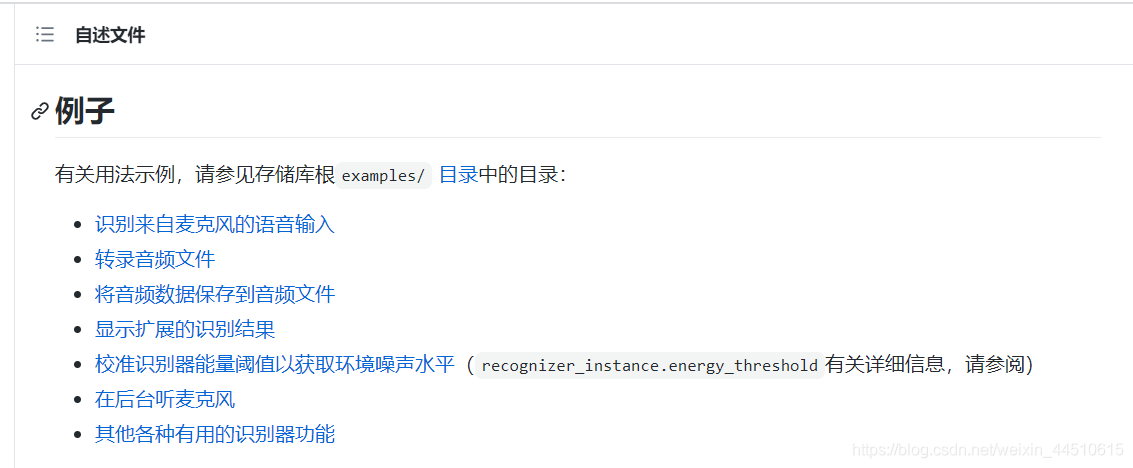
本文共 3321 字,大约阅读时间需要 11 分钟。
@Author:Runsen
1876年,亚历山大·格雷厄姆·贝尔(Alexander Graham Bell)发明了一种电报机,可以通过电线传输音频。托马斯·爱迪生(Thomas Edison)于1877年发明了留声机,这是第一台记录声音并播放声音的机器。
最早的语音识别软件之一是由Bells Labs在1952年编写的,只能识别数字。1985年,IBM发布了使用“隐马尔可夫模型”的软件,该软件可识别1000多个单词。
几年前,一个replace("?","")代码价值一个亿
如今,在Python中Tensorflow,Keras,Librosa,Kaldi和语音转文本API等多种工具使语音计算变得更加容易。
今天,我使用gtts和speech_recognition,教大家如何通过三十行代码,打造一款简单的人工语音对话。思路就是将语音变成文本,然后文本变成语音。
gtts
gtts是将文字转化为语音,但是需要在VPN下使用。这个因为要接谷歌服务器。
具体:
下面,让我们看一段简单的的代码
from gtts import gTTSdef speak(audioString): print(audioString) tts = gTTS(text=audioString, lang='en') tts.save("audio.mp3") os.system("audio.mp3") speak("Hi Runsen, what can I do for you?") 执行上面的代码,就可以生成一个mp3文件,播放就可以听到了Hi Runsen, what can I do for you?。这个MP3会自动弹出来的。
speech_recognition
speech_recognition用于执行语音识别的库,支持在线和离线的多个引擎和API。
speech_recognition具体
安装speech_recognition可以会出现错误,对此解决的方法是通过安装对应的whl包
在官方文档中提供了具体的识别来自麦克风的语音输入的

下面就是 speech_recognition 用麦克风记录下你的话,这里我使用的是
recognize_google,speech_recognition 提供了很多的类似的接口。import timeimport speech_recognition as sr# 录下来你讲的话def recordAudio(): # 用麦克风记录下你的话 print("开始麦克风记录下你的话") r = sr.Recognizer() with sr.Microphone() as source: audio = r.listen(source) data = "" try: data = r.recognize_google(audio) print("You said: " + data) except sr.UnknownValueError: print("Google Speech Recognition could not understand audio") except sr.RequestError as e: print("Could not request results from Google Speech Recognition service; {0}".format(e)) return dataif __name__ == '__main__': time.sleep(2) while True: data = recordAudio() print(data) 下面是我乱说的英语

对话
上面,我们实现了用麦克风记录下你的话,并且得到了对应的文本,那么下一步就是字符串的文本操作了,比如说how are you,那回答"I am fine”,然后将"I am fine”通过gtts是将文字转化为语音
# @Author:Runsen# -*- coding: UTF-8 -*-import speech_recognition as srfrom time import ctimeimport timeimport osfrom gtts import gTTS# 讲出来AI的话def speak(audioString): print(audioString) tts = gTTS(text=audioString, lang='en') tts.save("audio.mp3") os.system("audio.mp3")# 录下来你讲的话def recordAudio(): # 用麦克风记录下你的话 r = sr.Recognizer() with sr.Microphone() as source: audio = r.listen(source) data = "" try: data = r.recognize_google(audio) print("You said: " + data) except sr.UnknownValueError: print("Google Speech Recognition could not understand audio") except sr.RequestError as e: print("Could not request results from Google Speech Recognition service; {0}".format(e)) return data# 自带的对话技能(逻辑代码:rules)def jarvis(): while True: data = recordAudio() print(data) if "how are you" in data: speak("I am fine") if "time" in data: speak(ctime()) if "where is" in data: data = data.split(" ") location = data[2] speak("Hold on Runsen, I will show you where " + location + " is.") # 打开谷歌地址 os.system("open -a Safari https://www.google.com/maps/place/" + location + "/&") if "bye" in data: speak("bye bye") breakif __name__ == '__main__': # 初始化 time.sleep(2) speak("Hi Runsen, what can I do for you?") # 跑起 jarvis() 
当我说how are you?会弹出I am fine的mp3

当我说where is Chiana?会弹出Hold on Runsen, I will show you where China is.的MP3

 本项目对应的
本项目对应的 转载地址:https://maoli.blog.csdn.net/article/details/117037126 如侵犯您的版权,请留言回复原文章的地址,我们会给您删除此文章,给您带来不便请您谅解!
发表评论
最新留言
关于作者
